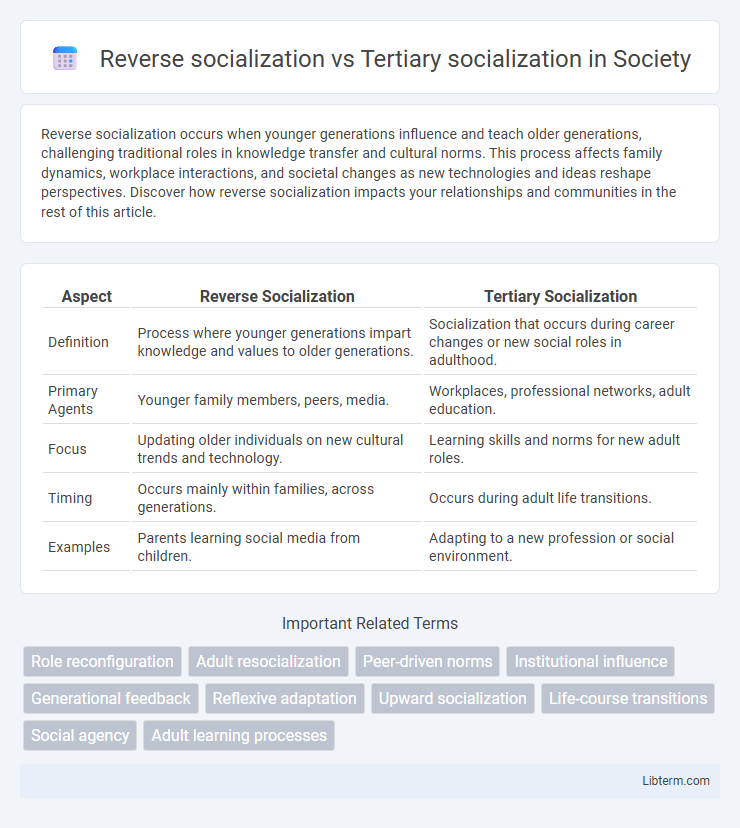Reverse socialization occurs when younger generations influence and teach older generations, challenging traditional roles in knowledge transfer and cultural norms. This process affects family dynamics, workplace interactions, and societal changes as new technologies and ideas reshape perspectives. Discover how reverse socialization impacts your relationships and communities in the rest of this article.
Table of Comparison
| Aspect | Reverse Socialization | Tertiary Socialization |
|---|---|---|
| Definition | Process where younger generations impart knowledge and values to older generations. | Socialization that occurs during career changes or new social roles in adulthood. |
| Primary Agents | Younger family members, peers, media. | Workplaces, professional networks, adult education. |
| Focus | Updating older individuals on new cultural trends and technology. | Learning skills and norms for new adult roles. |
| Timing | Occurs mainly within families, across generations. | Occurs during adult life transitions. |
| Examples | Parents learning social media from children. | Adapting to a new profession or social environment. |
Understanding Socialization: An Overview
Reverse socialization occurs when younger individuals influence the beliefs, values, or behaviors of older generations, contrasting traditional socialization's flow from elders to youth. Tertiary socialization refers to the process of adapting to new roles or environments later in life, often involving professional or institutional settings. Understanding socialization requires recognizing these dynamics as part of lifelong learning and role adaptation within diverse social contexts.
Defining Reverse Socialization
Reverse socialization occurs when younger generations influence the attitudes, values, or behaviors of older generations, challenging traditional social roles. It contrasts with tertiary socialization, which involves the integration of individuals into new social environments during adulthood, often through experiences such as workplace training or joining social groups. Understanding reverse socialization highlights the dynamic nature of social learning across age groups, emphasizing the bidirectional flow of cultural knowledge and social norms.
What is Tertiary Socialization?
Tertiary socialization refers to the process by which adults adapt to new roles, norms, and cultural environments, often occurring in professional or institutional settings such as workplaces, military service, or rehabilitation centers. Unlike primary and secondary socialization, which happen during childhood and adolescence, tertiary socialization enables individuals to modify their identities to fit new social contexts later in life. This stage is crucial for continuous personal development and successful integration into evolving social structures.
Key Differences Between Reverse and Tertiary Socialization
Reverse socialization occurs when younger generations influence older generations, often seen with technology adoption, whereas tertiary socialization involves adapting to new roles or environments, such as entering a workplace or institution. The key difference lies in the direction of influence: reverse socialization flows upward from youth to elders, while tertiary socialization centers on individual adjustment to novel social settings later in life. Reverse socialization emphasizes generational transfer of cultural norms, whereas tertiary socialization focuses on role-specific learning and integration.
Agents of Reverse Socialization
Agents of reverse socialization primarily include younger family members, such as children influencing their parents through exposure to new technologies, social norms, or cultural trends. Media platforms and peer groups also act as significant agents by shaping the attitudes and behaviors of older generations. This contrasts with tertiary socialization, which involves adapting to new roles in adulthood through agents like workplaces, professional networks, and organizational memberships.
Contexts for Tertiary Socialization
Tertiary socialization occurs in specialized contexts such as professional environments, higher education institutions, and organizational settings, where individuals adopt norms and behaviors relevant to new roles and statuses. Unlike reverse socialization, which involves younger generations influencing older ones, tertiary socialization primarily focuses on adult individuals adapting to complex social structures and subcultures. These contexts facilitate skill acquisition, identity reshaping, and value internalization critical for effective participation in advanced social and occupational domains.
Impacts on Individual Identity Formation
Reverse socialization, where younger generations influence older ones, challenges traditional norms and reshapes the identity of older individuals by introducing new values and behaviors. Tertiary socialization occurs in adulthood, often through professional or specialized environments, reinforcing or reshaping identity based on new roles and societal expectations. Both processes significantly impact individual identity formation by continuously adapting personal beliefs and social roles throughout the life course.
Societal Implications of Both Socialization Types
Reverse socialization disrupts traditional hierarchies as younger generations influence older ones, reshaping cultural norms and driving generational shifts in technology use, language, and values. Tertiary socialization integrates individuals into new societal roles through institutions like workplaces or religious organizations, reinforcing social cohesion and facilitating adaptation to complex social environments. Both processes impact societal stability and innovation, with reverse socialization accelerating cultural change and tertiary socialization maintaining continuity and institutional legitimacy.
Case Studies and Real-World Examples
Case studies highlight reverse socialization as the process where younger generations influence older family members' values or norms, such as teenagers teaching parents new technology or social media behaviors. Tertiary socialization occurs in professional settings, exemplified by employees adapting to organizational culture after initial socialization phases, seen in corporate onboarding programs. Real-world examples demonstrate reverse socialization in immigrant families where children assimilate faster and impact parents' cultural adaptation, while tertiary socialization is evident in military recruits internalizing discipline and values during advanced training phases.
Future Trends in Socialization Processes
Future trends in socialization processes highlight the growing impact of reverse socialization, where younger generations increasingly influence the behaviors and values of older family members through digital media and technology. Tertiary socialization expands beyond traditional institutions, emphasizing lifelong learning and adaptability within virtual environments and global networks. Emerging technologies, such as augmented reality and AI-driven social platforms, are reshaping how individuals continuously acquire social norms and skills throughout their lifespan.
Reverse socialization Infographic

 libterm.com
libterm.com